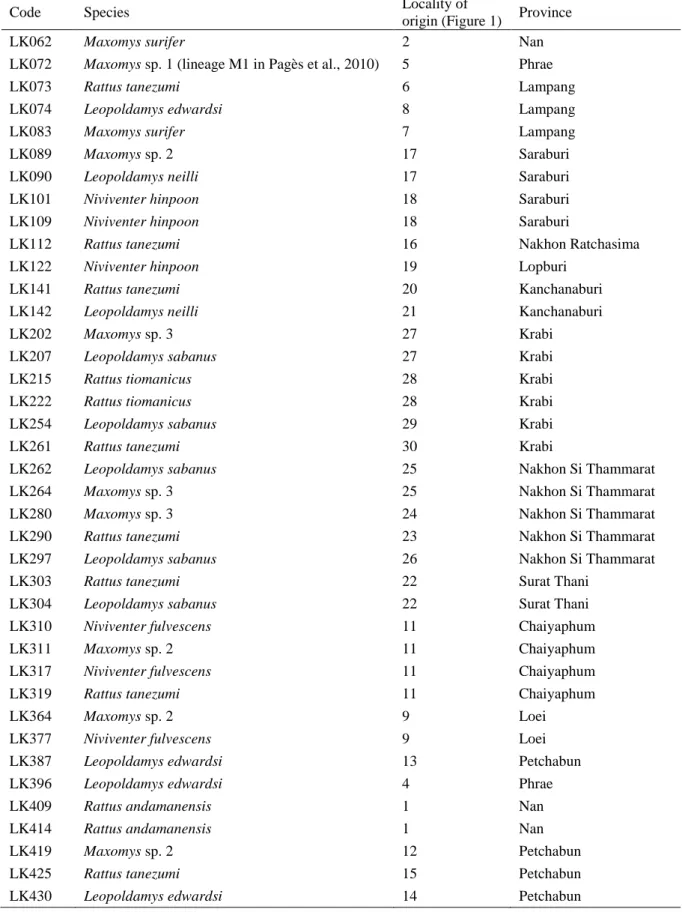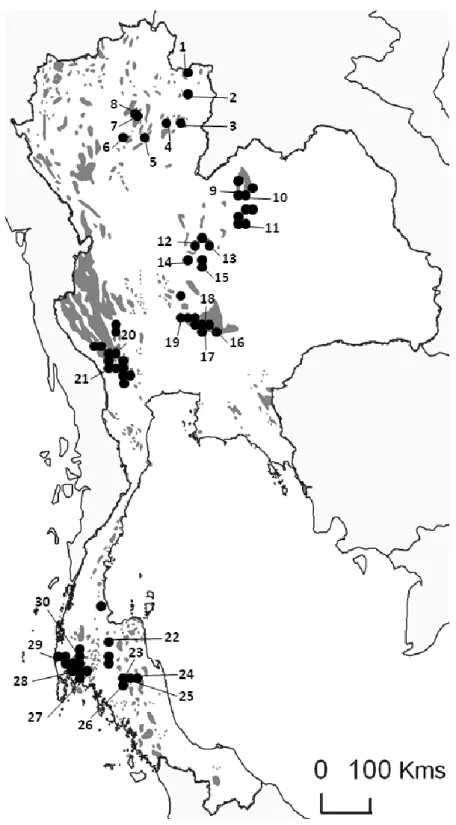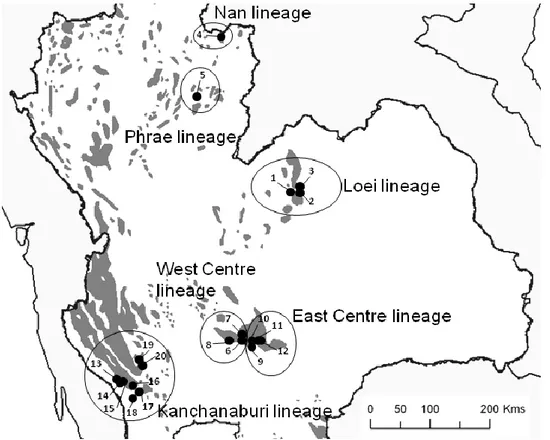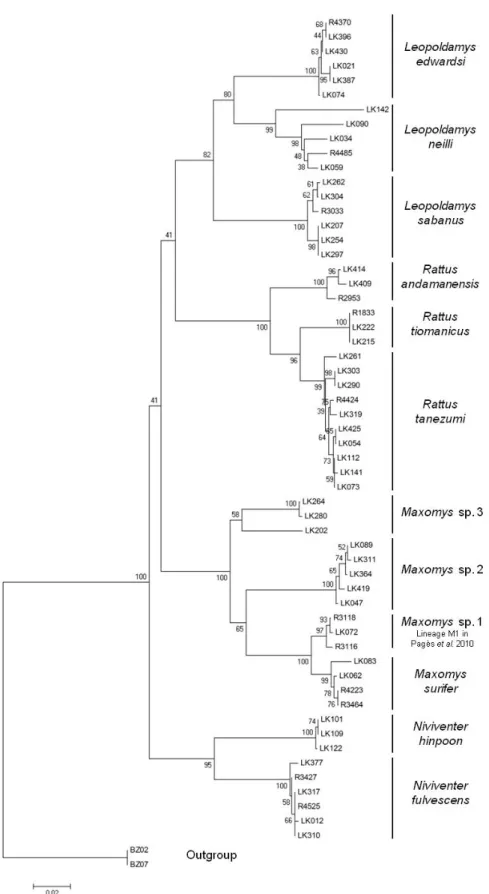Thai limestone karsts: an impending biodiversity crisis
Alice Latinne1*, Surachit Waengsothorn2, Vincent Herbreteau3, Johan R. Michaux1,4
1Institut de Botanique (Bat. 22), Université de Liège, 4000 Liège (Sart Tilman), Belgium.
E-mail : alice.latinne@ulg.ac.be
2
Thailand Institute of Scientific and Technological Research, Bangkok, Thailand
3CIRAD, UR AGIRs (Animal et Gestion Intégrée des Risques), Campus International de Baillarguet, CS 30016,
34988 Montferrier-sur-Lez cedex France
4CBGP (Centre de Biologie et de Gestion des Populations), UMR INRA/IRD/Cirad/Montpellier SupAgro,
Campus international de Baillarguet, CS 30016, 34988 Montferrier-sur-Lez cedex France
Abstract
Due to the high level of endemic species that they support and the high threats they are facing, such as unsustainable limestone quarrying, hunting and urbanization, limestone karsts are recognized as biodiversity hotspots needing urgent protection.
The first aim of our study was to investigate the mammal rodent diversity of Thai limestone karsts. Our second aim was to examine the diversity at a finer scale than the species level (intraspecific biodiversity) using phylogeographic approaches. Therefore, we studied the phylogeographic structure of a threatened rodent, endemic to limestone karsts of Thailand, the Murinae Leopoldamys neilli. We sampled 76 limestone karsts in whole Thailand and live-trapped 444 rodents including 115 Leopoldamys neilli.
Our study revealed an important rodent diversity in Thai limestone karsts. Besides endemic rodent species, karsts also host typical forest species to which they provide forest refugia in deforested regions. At the intraspecific level, our study revealed an unexpected high level of genetic differentiation within the rodent species L. neilli. As each limestone area of Thailand is characterized by a particular genetic lineage of L. neilli, the destruction of these karsts would lead to the disappearance of unique intraspecific strains not found elsewhere. Our results highlight the importance of protecting limestone habitats to preserve not only their interspecific but also intraspecific rodent diversity that is highly threatened as more than 20% of limestone karsts in Thailand have already been quarried. Management plans of limestone, a non-renewable resource, should urgently take into account this high biological importance of karsts.
Keywords: Thailand; rodent diversity; limestone karsts; conservation; Leopoldamys neilli
1. Introduction
Limestone karsts are sedimentary rock outcrops consisting of calcium carbonate created millions of years ago by calcium-secreting marine organisms, and subsequently lifted above sea level by tectonic movement (Clements et al., 2006). Within Southeast Asia, karsts cover an area of 460,000 km² - about 10% of the total land area of this region (Day & Urich, 2000). Southeast Asian limestone karsts are highly threatened by unsustainable limestone quarrying, hunting and urbanization (Vermeulen & Whitten, 1999; Clements et al., 2006). Limestone is an extremely important raw material and is used in Thailand in 14 major industries as crushed rock for building and construction, cement and lime among others (ESCAP, 2001). More than 122 limestone mines are operating in Thailand and more than 20% of limestone karsts in Thailand have already been quarried (World Bank, 2004).
Southeast Asian limestone karsts support very high level of endemic species of plants, vertebrates and invertebrates (Vermeulen & Whitten, 1999; Schilthuizen et al., 2005;
Clements et al., 2006; 2008) and are recognized as biodiversity hotspots of high biological importance (Vermeulen & Whitten, 1999; Clements et al., 2006). Thai limestone karsts host several endemic animals, among which are two rodent species, Leopoldamys neilli and
Niviventer hinpoon, one bird species, Napothera crispifrons calcicola, at least seven fish
species and dozens of snails species (World Bank, 2004). However, limestone karsts remain poorly studied despite their great scientific interest (Sodhi et al., 2010) and they urgently need an increase of biological knowledge to better preserve their huge biodiversity.
The first aim of this study was to develop a mammal rodent diversity inventory of Thai limestone karsts on the basis of morphological as well as genetics methodologies.
Our second aim was to examine the rodent diversity at a finer scale than the species level (intraspecific biodiversity) using phylogeographic approaches. Indeed, in contrast to other regions in the world, the Southeast Asian region is poorly studied on this point of view, as only 3.3% of the phylogeographic studies published between 1987 and 2006 concern taxa from this region (Beheregaray, 2008). Phylogeographic approaches therefore appear highly important to better understand the level of limestone karsts biodiversity, not only on the interspecific but also intraspecific level. Therefore, we studied the phylogeographic structure of a threatened rodent, endemic to limestone karsts of Thailand, the Murinae Leopoldamys
neilli based on molecular markers. L. neilli, a large and long-tailed rat with grayish-brown fur
and a white belly, was discovered in 1973 in Saraburi province, central Thailand (Lekagul & McNeely, 1988). The species has also been recorded in a few locations in north and southwest Thailand (Lekagul & McNeely 1988; Waengsothorn et al., 2007). L. neilli was previously classified as “Endangered” on the IUCN Red List, but is now listed as “Data deficient” since very little information is available about its biology and ecology (IUCN, 2010).
2. Material & Methods
2.1 Mammal rodent diversity inventory
A total of 444 mammal rodents were collected (live-trapped) in limestone karsts from 76 localities in 15 provinces of Thailand (Figure 1). All the collected animals were released after sampling of a small piece of ear skin. The skin samples were stored in 96% ethanol. Forty-five samples (Table 1) were selected among the 444 specimens in order to maximize the number of species and geographic locations and were used in phylogenetic analyses. Field identifications were made based on morphological criteria according to Lekagul & McNeely (1988) and Corbet & Hill (1992).
Table 1. Samples used in the biodiversity inventory
Code Species Locality of
origin (Figure 1) Province
LK012 Niviventer fulvescens 9 Loei
LK021 Leopoldamys edwardsi 9 Loei
LK034 Leopoldamys neilli 10 Loei
LK047 Maxomys sp. 2 10 Loei
LK054 Rattus tanezumi 3 Nan
Table 1. Samples used in the biodiversity inventory (cont.)
Code Species Locality of
origin (Figure 1) Province
LK062 Maxomys surifer 2 Nan
LK072 Maxomys sp. 1 (lineage M1 in Pagès et al., 2010) 5 Phrae
LK073 Rattus tanezumi 6 Lampang
LK074 Leopoldamys edwardsi 8 Lampang
LK083 Maxomys surifer 7 Lampang
LK089 Maxomys sp. 2 17 Saraburi
LK090 Leopoldamys neilli 17 Saraburi
LK101 Niviventer hinpoon 18 Saraburi
LK109 Niviventer hinpoon 18 Saraburi
LK112 Rattus tanezumi 16 Nakhon Ratchasima
LK122 Niviventer hinpoon 19 Lopburi
LK141 Rattus tanezumi 20 Kanchanaburi
LK142 Leopoldamys neilli 21 Kanchanaburi
LK202 Maxomys sp. 3 27 Krabi
LK207 Leopoldamys sabanus 27 Krabi
LK215 Rattus tiomanicus 28 Krabi
LK222 Rattus tiomanicus 28 Krabi
LK254 Leopoldamys sabanus 29 Krabi
LK261 Rattus tanezumi 30 Krabi
LK262 Leopoldamys sabanus 25 Nakhon Si Thammarat
LK264 Maxomys sp. 3 25 Nakhon Si Thammarat
LK280 Maxomys sp. 3 24 Nakhon Si Thammarat
LK290 Rattus tanezumi 23 Nakhon Si Thammarat
LK297 Leopoldamys sabanus 26 Nakhon Si Thammarat
LK303 Rattus tanezumi 22 Surat Thani
LK304 Leopoldamys sabanus 22 Surat Thani
LK310 Niviventer fulvescens 11 Chaiyaphum
LK311 Maxomys sp. 2 11 Chaiyaphum
LK317 Niviventer fulvescens 11 Chaiyaphum
LK319 Rattus tanezumi 11 Chaiyaphum
LK364 Maxomys sp. 2 9 Loei
LK377 Niviventer fulvescens 9 Loei
LK387 Leopoldamys edwardsi 13 Petchabun
LK396 Leopoldamys edwardsi 4 Phrae
LK409 Rattus andamanensis 1 Nan
LK414 Rattus andamanensis 1 Nan
LK419 Maxomys sp. 2 12 Petchabun
LK425 Rattus tanezumi 15 Petchabun
Figure 1: Sampling locations of this study. Shaded areas represent the distribution of limestone karsts in Thailand. Black dots represent the 76 limestone karsts sampled in this study. Sampling localities of the 45 Rattini specimens included in our phylogeny and biodiversity inventory are numbered (see Table 1).
Genomic DNA was extracted from skin samples using the DNeasy Tissue Kit (Qiagen Inc., Valencia, California) following the manufacturer‟s instructions.
One mitochondrial marker, the cytochrome b gene (cytb) (1000 bp), was amplified for the 45 samples using primers H6 TCTCCATTTCTGGTTTACAAGAC-3‟) and L7 (5‟-ACCAATGACATGAAAAATCATCGTT-3‟). A phylogenetic tree was reconstructed using the Neighbor-Joining method with 100 bootstraps implemented in MEGA v4.1 (Tamura et
al., 2007). To allow accurate species identification and confirm our field identification based
on morphological criteria, several cytb sequences belonging to voucher specimens from Pagès
et al. (2010) and available on GenBank were added to our dataset (Leopoldamys edwardsi:
R4370, Leopoldamys neilli: R4485, Leopoldamys sabanus: R3033, Rattus andamanensis: R2953, Rattus tiomanicus: R1833, Rattus tanezumi: R4424, Maxomys surifer: R4223-R3464,
Maxomys sp.: R3118-R3116, Niviventer fulvescens: R3427-R4525). Two sequences of Micromys were used as outgroup.
2.2 Phylogeography of L. neilli
A total of 115 Leopoldamys neilli collected (live-trapped) in limestone karsts from 20 localities in 7 provinces of Thailand (Loei, Nan, Phrae, Saraburi, Nakhon Ratchasima, Lopburi, Kanchanaburi provinces) has been analyzed (Figure 2). Field specimen identifications and locality information are given in Latinne et al. (2011).
Figure 2 (modified from Latinne et al., 2011): Sampling localities of the 115 Leopoldamys
neilli analyzed in this study and geographic distribution of the different genetic lineages
observed within L. neilli in Thailand. Shaded areas represent the distribution of limestone karsts in Thailand.
Two mitochondrial markers, the cytochrome b gene (cytb) (900 bp) and the cytochrome c oxydase subunit I gene (COI) (713 bp), were amplified for all the L. neilli samples. Moreover, a nuclear locus, the β-fibrinogen intron 7 (bfibr) (745 bp), was targeted for a subset of 65 samples representative of the main mitochondrial clades found, using primers designed by Seddon et al. (2001). DNA extraction and amplification are detailed in Latinne et al. (2011).
Phylogenetic trees were reconstructed for the phylogeographic purposes using two probabilistic approaches: the maximum likelihood method (ML) and Bayesian inferences (BI) as described in Latinne et al. (2011). Analyzes were run on the three combined genes dataset (cytb/COI/bfibr). A median joining network was performed with NETWORK v4.5.1.6. (Bandelt et al., 1999) to explore relationships between haplotypes of the combined dataset (cytb/COI/bfibr).
Haplotype (h) and nucleotide (π) diversities of the main lineages corresponding to the studied karstic regions were estimated for each locus using Arlequin 3.11 (Excoffier et al., 2005). An Analysis of Molecular Variance (AMOVA) performed on the combined dataset (cytb/COI/bfibr) in Arlequin 3.11 was used to assess the distribution of genetic variation among populations. The genetic groups were defined as detailed in Latinne et al. (2011). The genetic differentiation between lineages was assessed using population pairwise Fst and Nst calculated in DNASP v5 (Librado & Rozas, 2009).
3. Results
3.1 Mammal rodent diversity inventory
According to our phylogeny (Figure 3), four genera belonging to the Rattini tribe were encountered in our sampling sites: Leopoldamys, Rattus, Maxomys and Niviventer. Three
Leopoldamys species (L. edwardsi, L. neilli, L. sabanus), three Rattus species (R. andamanensis, R. tiomanicus, R. tanezumi), four Maxomys species (M. surifer, M. sp. 1, M.
sp. 2, M. sp. 3) and two Niviventer species (N. fulvescens, N. hinpoon) were identified in our dataset.
3.2 Phylogeography of L. neilli
The phylogenetic tree (Figure 4) and median joining network (data not shown) of the three combined genes gave similar results and indicated that the 36 haplotypes clustered into six geographically well-structured lineages: Loei lineage (samples from Loei province), Phrae lineage (samples from Phrae province), Nan lineage (samples from Nan province), West Centre lineage (samples from Lopburi province and from the western part of Saraburi province), East Centre lineage (samples from Nakhon Ratchasima province and from the eastern part of Saraburi province) and Kanchanaburi lineage (samples from Kanchanaburi province) (Figure 2). The monophyly of these lineages is very well supported with BS: 100% - BP: 1.0.
Figure 3: Neighbor-Joining phylogenetic tree depicting relationships among Rattini species of Thai limestone karsts. Bootstrap supports (100 replicates) of the nodes are indicated above the branches.
Figure 4: Maximum likelihood tree summarizing the phylogenetic relationships among the 36 haplotypes of the studied populations based on the three combined genes (GTR + G model). The same topology was obtained with the Bayesian analyses. Bootstrap support (1000 replicates)/posterior probabilities are indicated above the branches. The geographic distribution of each haplotype has been included in parentheses (see Figure 1 for numbers and localities correspondences).
Haplotype and nucleotide diversities were calculated for the six main lineages for the three independent markers (cytb, COI, and bfibr). The results indicate that all the lineages show a very low genetic diversity for all the markers (between 0 and 0.81 for haplotype diversity and between 0 and 0.58% for nucleotide diversity).
The AMOVA performed on the three combined genes dataset showed that 94% of variation is explained by differences among geographical groups, whereas only 2% and 4% of this variation are explained by differences among populations within groups and within populations, respectively.
Fst and Nst values calculated on the three combined genes dataset are very high among lineages (>0.9), evidencing low gene flow among them.
4. Discussion
4.1 Interspecific rodent diversity of Thai limestone karsts
Our study revealed an important rodent diversity in Thai limestone karsts. The two species of Thai rodent endemic to limestone karsts, Leopoldamys neilli and Niviventer
hinpoon, have been identified in our sampling sites and share narrow ecological niche. Our
2010) but extends its geographical range to the northern (Nan and Phrae provinces) part of Thailand. The distribution range of N. hinpoon appears to be more restricted and limited to karst area of central Thailand (Saraburi and Lopburi provinces). The high endemicity of N.
hinpoon to limestone karsts of this region makes this species highly vulnerable and threatened
by habitat destruction.
Besides endemic species, Thai limestone karsts also host typical rodent forest species.
Leopoldamys edwardsi, Leopoldamys sabanus, Rattus andamanensis, Maxomys surifer and Niviventer fulvescens are all living in wild forest ecosystems (Lekagul & McNeely, 1988).
Since Thailand has lost about 30% of its forest cover between 1950 and 2000 (World Bank, 2004), limestone karsts provide important forest refugia for these species in deforested and highly developed regions. Rattus tiomanicus and R. tanezumi are highly adaptable species living in a large variety of habitats from domestic and agricultural to natural environments. It is interesting to note that their generalist ecology allow them to live also in limestone karsts. Our study also evidenced the presence in the studied areas of two additional Maxomys species (Maxomys sp. 2 and Maxomys sp. 3) not found in the study of Pagès et al. (2010). The
Maxomys sp. 3 lineage includes specimens from southern Thailand (Krabi and Nakhon Si
Thammarat provinces). This region represents the northern limit of the geographical range of two Maxomys species: M. rajah and M. whiteheadi (Wilson & Reeder, 2005). So the
Maxomys sp. 3 lineage could be one of these species. The Maxomys sp. 2 lineage includes
specimens from central and northeastern Thailand (Saraburi, Petchabun, Loei and Chaiyaphum provinces) where M. surifer is the only Maxomys species reported. Further investigations using independent data (morphology, nuclear genes) will help to determine if these two lineages correspond to cryptic species endemic to the limestone karsts or if they belong to species already described in Thailand but not analysed in previous genetic studies. 4.2 Intraspecific rodent diversity of Thai limestone karsts
Our study evidenced a high geographic structure of the genetic diversity for L. neilli. Indeed, six highly differentiated genetic lineages were observed. Each of them corresponds to particular regions of Thailand (Loei, Nan, Phrae, Nakhon Ratchasima, Saraburi-Lopburi, Kanchanaburi provinces) and gene flows between them are extremely low. These results are surprising as some populations are geographically very close to each other (Figure 2). Such fine-scale population differentiation at the intraspecific level is very rare among rodents and small mammals.
These results suggest a severe population fragmentation correlated to the scattered distribution of the karst habitat of this species; the lowland areas between limestone karsts thus act as biogeographical barriers and prevent gene flow between lineages. These results also attest the high endemicity of L. neilli to limestone karsts and its high ecological specialization.
4.3 Implication for conservation and management of limestone karsts
More than 20% of limestone karsts in Thailand have already been quarried for cement, lime and hard core, and many have completely disappeared from the landscape (World Bank, 2004). The cement production of Thailand has increased by about 10% every year in the early
2000‟s but is slightly decreasing since 2007 (ESCAP, 2001; Shi, 2008). An average of 37 Mt of cement is produced every year in Thailand (Shi, 2008). As a result of these activities, some endemic species became dramatically endangered. Management plans of limestone karsts should urgently take into account the high biological importance of karsts in order to protect their great biodiversity.
Our phylogenetic analyses proved the importance of limestone karsts in the conservation of Southeast Asian biodiversity as they host endemic species (L. neilli and N.
hinpoon) but also ubiquitous (R. tiomanicus and R. tanezumi) and forest (L. edwardsi, L. sabanus, R. andamanensis, M. surifer and N. fulvescens) species. Our study also evidenced
the existence of highly differentiated genetic lineages within L. neilli corresponding to different limestone regions spread all over Thailand. As the six L. neilli lineages that we described exchange very few migrants and are geographically and genetically isolated, they should be considered as distinct Management Units (MU) (Moritz, 1994; Avise, 2000), and may require separate management and conservation plans. This information is extremely important for the conservation of L. neilli. Indeed, as the Thai limestone areas are characterized by particular endemic genetic lineages of this species and as they are presently highly threatened by quarrying, hunting, and urbanization (Vermeulen and Whitten, 1999; Clements et al., 2006), it is very likely that each karst destruction will lead to the disappearance of unique intraspecific L. neilli lineages not found elsewhere in Southeast Asia. Large undisturbed limestone karsts areas should be preserved in each karst region of Thailand in order to protect the whole genetic diversity of L. neilli. We strongly suggest following the recommendations of Vermeulen & Whitten (1999) for limestone quarrying management and to avoid the quarrying of isolated limestone hills and to locate quarries in the largest limestone areas and let a considerable part of it untouched.
5. Conclusion
From the interspecific point of view, our molecular study revealed a high number of Rattini species living in Thai limestone karsts, confirming the importance of limestone karsts as forest refugia for rodents in deforested and developed regions. At the intraspecific level, our study revealed an unexpected high level of genetic differentiation within the species L.
neilli.
These results highlight the importance of protecting limestone habitats to preserve not only their interspecific but also intraspecific biodiversity that is highly threatened. Management plans of limestone, a non-renewable resource, should urgently take into account this high biological importance of karsts.
6. Acknowledgements
We thank Boonchai Tontan who worked hard in the field and help us to collect the samples used in this study. We are grateful to G. Vanhamel for his help in the lab. We express gratitude to S. Jittapalapong for his administrative help. This work was supported by a Belgian FRS-FNRS (Fonds National de la Recherche Scientifique) fellowship to A. Latinne
(mandate “aspirant”) and to J.R. Michaux (mandate “chercheur qualifié”). This study is part of the “CERoPath project” (Community Ecology of Rodents and their Pathogens in South-East Asia: effects of biodiversity changes and implications in health ecology), ANR Biodiversity ANR 07 BDIV 012, funded by the French National Agency for Research.
7. References
Avise, J.C. (2000) Phylogeography: The History and Formation of Species. Harvard University Press, Cambridge, Massachusetts.
Bandelt, H.J., Forster, P. & Röhl, A. (1999) Median-joining networks for inferring intraspecific phylogenies. Molecular Biology and Evolution, 16, 37–48.
Beheregaray, L.B. (2008) Twenty years of phylogeography: the state of the field and the challenges for the Southern Hemisphere. Molecular Ecology, 17, 3754-3774.
Clements, R., Sodhi, N.S., Schilthuizen, M. & Ng, P.K.L. (2006) Limestone karsts of Southeast Asia: imperiled arks of biodiversity. Bioscience, 56, 733–742.
Clements, R., Ng, P.K.L., Lu, X.X., Ambu, S., Schilthuizen, M. & Bradshaw, C.J.A. (2008) Using biogeographical patterns of endemic land snails to improve conservation planning of limestone karsts. Biological Conservation, 141, 2751–2764.
Corbet, G. & Hill, J. (1992) The Mammals of the Indomalayan Region: A Systematic Review. Oxford University Press, USA.
Day, M.J. & Urich, P.B. (2000) An assessment of protected karst landscapes in Southeast Asia. Cave and Karst Science, 27, 61–70.
ESCAP, Economic and Social Commission for Asia and the Pacific. (2001) Atlas of Mineral resources of the ESCAP region, Volume 16, Mineral Resources of Thailand. United Nations, New York.
Excoffier, L., Laval, G. & Schneider, S. (2005) Arlequin ver 3.0: An integrated software package for population genetics data analysis. Evolutionary Biology Online, 1, 47-50. IUCN (2010). Leopoldamys neilli. IUCN Red List of Threatened Species (ed. by IUCN
2010). Version 2010.1.
Latinne, A., Waengsothorn, S., Herbreteau, V. & Michaux, J.R. (2011) Evidence of a complex phylogeographic structure for the threatened rodent Leopoldamys neilli, in South East Asia. Conservation Genetics, submitted.
Lekagul, B. & McNeely, J.A. (1988) Mammals of Thailand. White Lotus Press, Bangkok, Thailand.
Librado, P. & Rozas, J. (2009) DnaSP v5: A software or comprehensive analysis of DNA polymorphism data. Bioinformatics, 25, 1451-1452.
Moritz, C. (1994) Defining „evolutionarily significant units‟ for conservation. Trends in Ecology and Evolution, 9, 373-375.
Pagès, M., Chaval, Y., Waengsothorn, S., Cosson, J.F., Hugot, J.P., Morand, S. & Michaux, J. (2010) Refining the taxonomy of the Rattini tribe: a phylogeny-based delimitation of species boundaries. BMC evolutionary Biology, In Press.
Schilthuizen, M., Liew, T-S., Bin Elahan, B. & Lackman-Ancrenaz, I. (2005) Effects of karst forest degradation on pulmonate and prosobranch land snail communities in Sabah, Malaysian Borneo. Conservation Biology, 19, 949–954.
Seddon, J.M., Santucci, F., Reeve, N.J. & Hewitt, G.M. (2001) DNA footprints of European hedgehogs, Erinaceus europaeus and E. concolor: Pleistocene refugia, postglacial expansion and colonization routes. Molecular Ecology, 10, 2187-2198.
Shi, L. (2008) The Mineral Industry of Thailand. In Minerals yearbook, Vol. III, International. U.S. Geological survey.
Sodhi, N.S., Posa, M.R.C., Lee, T.M., Bickford, D., Koh, L.P. & Brook, B.W. (2010) The state and conservation of Southeast Asian biodiversity. Biodiversity and Conservation, 19, 317–328.
Tamura, K., Dudley, J., Nei, M. & Kumar, S. (2007) MEGA4: Molecular Evolutionary Genetics Analysis (MEGA) software version 4.0. Molecular Biology and Evolution, 24, 1596-1599.
Vermeulen, J. & Whitten, T. (1999) Biodiversity and Cultural Property in the Management of Limestone Resources – Lessons from East Asia. World Bank, Washington, DC.
Waengsothorn, S., Nabhitabhata, J. & Moochan, T. (2007) The ecological distribution of Thai endemic rodents with a new distributional range of Niviventer hinpoon. The Thailand Natural History Museum Journal, 2, 31-42.
Wilson D, Reeder D (2005) Mammal Species of the World: A Taxonomic and Geographic Reference. 3rd edition. Johns Baltimore, Maryland: Hopkins University Press.
World Bank (2004). Thailand Environment Monitor 2004, Biodiversity conservation. World Bank Report, http://go.worldbank.org/VPRE208MZ0





